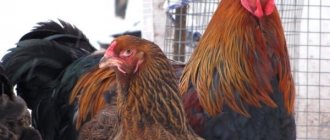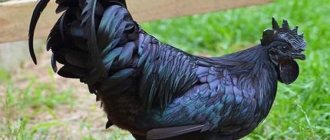Home » Articles about chickens » Highsex chicken breed
The four-line Hisex cross was bred for industrial breeding. This hybrid breed of chickens is characterized by high egg production - along with Leghorns it is considered one of the leaders in the egg production field.
Hisex chicken breed - origin
The Hisex breed of chickens has long been well known as crosses, since it does not belong to an independent breed.
Many farmers know this fact, which in no way detracts from their interest in breeding this type of bird. The product of many years of ornithologist's work, born through the genesis of the White Leghorn and New Hampshire families, there are two variants of plumage pigmentation, these are superficial differences within the framework of creating a hybrid. Thus, the names White and Brown belong to the white and brown color families, respectively.
This species is very young - its appearance dates back to the 70th year of the twentieth century, and scientists from the Dutch Eurybrid farm worked on breeding the newcomer.
History of appearance
The history of the appearance of Hisex White chickens is quite prosaic and similar to hundreds of other cross species. It was bred in Holland between 1968 and 1970 at the Euribrid agricultural base. To do this, breeders crossed the egg Leghorn and the New Hampshire meat and egg breed of American origin.
The experience was so successful that the resulting cross was literally immediately highly appreciated by experts and began to gain wide popularity. Just 4 years later, they already appeared in the USSR, where they were tested on one of the farms, and after confirming the high results, they began to spread throughout the state. Today the breed is one of the most popular
Content Features
Breeding highsec chickens is a fairly profitable business. But in order for productivity to remain at a high level and for the birds to feel good, care should be taken in advance about the conditions of their keeping. When arranging a chicken coop - a place of permanent residence of individuals, the following rules must be observed.
- When choosing a room, remember that there must be at least 0.25 m3 of free space per bird.
- The room for keeping chickens should have several windows, which will allow it to be illuminated during daylight hours. In addition, artificial lighting must be provided to prevent manifestations of cannibalism. Lighting in the chicken coop should be present for seventeen hours a day - only under this condition will egg production be at a high level.
- The temperature in the room should always be at least +12° degrees, otherwise the hens will not only stop laying eggs, but may also freeze. If there are chickens, then the temperature regime should be even more favorable.
- The chicken coop should provide good ventilation, but completely eliminate drafts. Also, the room should be dry; high humidity has a negative impact on the health of the birds.
- Initially, the floor will need to be covered with hay, sawdust or seed husks. The thickness of the poured layer should be six centimeters. In the future, the layer is not removed, but only a fresh one is poured onto it.
- Perches are installed along the walls - all at the same level from the floor, which is 60 cm. It is impossible to make them at different levels - this can provoke hostility between chickens for the best places.
- For laying hens, comfortable nests made of hay are installed in the farthest and darkest corners.
- Be sure to install a container with sand, which will allow the birds to clean their crops and satisfy their calcium needs.
- For walking, you can arrange a spacious pen or allow the chickens to walk directly in the yard.
The diet of adult chickens and roosters consists of a mixture of cereals and legumes, vegetables, herbs, mineral supplements, or they can be fed with factory-made feed. They are balanced in composition and contain the necessary mineral and vitamin complex. To increase productivity, fish meal, fresh fish, nettles, and universal premixes are added to the diet of laying hens. The food must contain protein.
Chickens are fed porridge, finely chopped boiled eggs, flattened grain, and in the first ten days of life - only ready-made factory feed. Young animals under two weeks of age should be fed eight times a day.
Fresh water should always be present in sufficient quantity. From time to time, a little potassium permanganate should be added to it to prevent bird diseases.
As for getting chickens, it is quite difficult to breed them at home. In addition, the offspring are unable to inherit the high productivity of their parents. The fact is that highsec is not a breed, but a cross or hybrid bred in a laboratory. In addition, highsec chickens are completely devoid of maternal instinct - they do not hatch eggs.
You can get chickens at home in two ways:
- buy hatching eggs from a breeding farm;
- buy chickens at a poultry farm.
For a review of the Highsec breed chickens, see below.
Nutrition
Haysa hybrids require feed with a high mineral content. It is recommended to give them food rich in vitamins and protein.
A well-designed diet should contain:
- cereals (wheat, oats, corn, barley) and legumes;
- fresh fish or fishmeal;
- meal, cake;
- vegetables (carrots, zucchini, pumpkin, boiled potatoes);
- vegetation (young nettles);
- coal, chalk, ground eggshells.
An adult bird eats about 115-120 g of food per day.
Advice! Place a container with sand in the chicken coop (this is a means for cleansing the crop and calcium for the shell).
Description of the variety
This hybrid can be called young, because it was bred less than half a century ago. Breeders tried to obtain a breed that would be highly productive and at the same time have high vitality. High line crosses have similar features. With its small size (up to two kilograms), the chicken lays large eggs, their weight exceeds the sixty gram mark. With good maintenance, they are capable of producing more than three hundred eggs per year, and egg production lasts for two to three years.
Like most laying hens, representatives of this breed mature early. Already at the age of four to five months they are able to give birth. At the same time, the survival rate of young individuals is 95 percent. Chickens of many egg breeds can boast of similar indicators - Leghorn, Sussex, New Hampshire, High Line.
The advantages of this cross include:
- small sizes;
- high performance;
- resistance to diseases;
- attractive appearance;
- calm character.
A distinctive feature of this type of poultry is its neat body and graceful movements. In addition, they are extremely active and mobile. Their appearance is quite attractive. Representatives of white and brown chickens are distinguished by a red comb that hangs to one side. They have beautiful silky plumage and a calm, balanced character. However, farmers prefer this breed not for its beautiful appearance and even temperament, but for its high productivity and excellent quality characteristics of eggs. Today, the Dutch cross Hisex Brown can be called the most egg-laying hen among all known varieties of laying hens.
Brown representatives of this cross are larger than chickens with white plumage. Their weight can reach two and a half kilograms. But they are not large breeds; even males are not of impressive size. But it is worth noting that their close relative, the American high line chicken, is even smaller in size; it rarely weighs more than one and a half kilograms.
The eggs of this cross have a similar, brown shell. They are very hardy and calm. They are unpretentious in their living conditions; these laying hens can easily tolerate changes in temperature or any changes in their usual diet. With intensive feeding, their weight gain occurs somewhat faster than that of white varieties.
Despite its unpretentiousness to living conditions, unlike the high line, the high line breed still requires some attention. If the most comfortable conditions are created for chickens of this breed, then their productivity will remain at the highest level for a long time. These birds need enough space, no more than four hens per cubic meter of area. Like the Sussex breed, they prefer floor-based housing. The chicken coop should be dry and clean, with a constant flow of fresh air into the room. For maximum productivity, it is good to try to maintain the temperature in the chicken coop within twelve degrees; lower temperatures will negatively affect the productivity and viability of the chickens. Don’t forget about the flooring, which should under no circumstances contain parasites.
Unlike the white variety of the breed, brown laying hens are more resistant to diseases and changes in living conditions. When installing perches, you should maintain a height of sixty centimeters from the floor. It is worth noting that performance will be maintained even in cellular living conditions. It is better to install nests in dark, dry corners. You should not skimp on hay when setting up roosts. To increase egg production, it is worth extending daylight hours for chickens by installing an additional light source in the chicken coop.
Conditions of detention and care
High productivity of Highsex chickens can be achieved by creating good living conditions for them and proper organization of feeding.
The interior space of the chicken coop must be equipped for comfortable living of the birds.
When arranging a chicken coop, you should adhere to the following rules:
- The area of the room is at least one square meter for 3-4 birds. Crowding in the chicken coop provokes fights and even cases of cannibalism (chickens begin to peck each other).
- No drafts or dampness. The chicken coop should be ventilated, but without access to cold air.
- The room temperature is not lower than 12-13 degrees. It is necessary to insulate the walls. A 5-7 centimeter thick bedding made of straw, sawdust or peat is laid on the floor.
- Cleanliness of the room. The litter is changed regularly. Walls, nests, perches, feeders are disinfected 2-3 times a year.
- The interior space of the chicken coop must be equipped for comfortable living of the birds. Perches 4-5 centimeters wide are installed at a height of 60-70 centimeters from the floor. The nests are hung on the walls to a height of 50-60 centimeters and covered with hay. Oblong-shaped feeders are placed at a height of 30-40 centimeters from the floor. The length of the feeder should ensure that all the chickens are located around it at the same time. The calculation is made in such a way that there is at least 25 centimeters per head.
- Additionally, a container with a sand-ash mixture is installed inside the chicken coop. This “bath” is designed to independently rid chickens of parasitic insects.
The room temperature should not fall below 12-13 degrees.
Highsex chickens can also be kept in cages. But the opportunity to walk under ultraviolet rays stimulates the production of vitamin D in the body of chickens, which significantly increases egg production.
Advantages and disadvantages of the breed (cross) of Hisex chickens
Among the advantages of the cross of Hisex chickens, according to reviews from the owners, are the following:
- Ability to withstand low temperatures while maintaining productivity.
- High survival rate of chicks and their good disposition.
- Good natural immunity to infectious and invasive diseases.
- Increased egg production rates, reaching maximum values with proper maintenance.
- Unpretentiousness to the conditions of detention and the diet offered by the farmer.
Among the negative aspects associated with keeping laying hens of this species, breeders name:
- Requirement for a spacious room.
- Difficulties caused by breeding birds, the need to constantly purchase breeding young animals to renew the herd.
- The majority of Highsex hens lack maternal instinct.
- The impossibility of transferring high performance characteristics when using birds of other breeds for breeding.
- High costs for balanced nutritious feed mixtures, the use of which achieves maximum egg production parameters.
Hisex chickens are highly productive hybrid individuals, characterized by maximum results with minimal investment. The breeders who dealt with them never tire of being amazed at the unpretentiousness and productivity of laying hens, demonstrated by them even in unfavorable conditions. However, if the minimum necessary conditions are provided, Highsexes, when entering the active egg-laying age early, are able to produce high-calorie, nutritious eggs for almost 3 years.
Video: interesting observations by a farmer of Hisex laying hens after purchasing from a poultry farm in 4 parts
Highsex chickens white video
We wish everyone success!
See modern products for poultry and livestock farmers that improve the health of pets and make our work easier.
Description of the Hisex cross
The Hisex hybrid is relatively young. Its appearance dates back to 1970 of the last century, and Dutch breeders were involved in breeding these birds. The main goal they set then was to breed a breed characterized by high egg production. It should be noted that the breeders completed their task with a bang.
With modest dimensions of up to 2 kg, Hisex chickens lay fairly large eggs weighing 63-65 grams. with a productivity of 300-320 eggs per year. And they will carry on productively for 2-3 years. Next in the video you can see how young roosters and hens of the breed in question behave!
Highsex laying hens are distinguished by early puberty (about 140 days) and high survival rate of the young - more than 95%. Both white and brown representatives of the Hisex chickens are endowed with a chic bright red comb that hangs coquettishly to one side. The plumage of these birds is smooth and silky, pleasant to the touch. The character of these birds is also excellent, they are active and energetic, but at the same time they are not cocky, like some of their relatives.
Hisex Brown
Brown Hisex laying hens are of the egg type, and earned their name due to their brownish-golden plumage. These chickens are somewhat larger than their white relatives, their weight reaches 2-2.4 kg. However, they still cannot be called large; even the roosters of this hybrid are not distinguished by their impressive dimensions. Under the right conditions, Brown hens produce about 300 eggs, with dark, intensely colored, strong shells.
Chickens of this breed are hardy and quite phlegmatic, less responsive to changes in climate or diet. Weight gain with higher feed consumption in these laying hens occurs more intensively than in the white subspecies.
Hisex White
Hisex white is quite popular in domestic poultry farms. The expression ideally characterizes this bird: minimum weight, maximum eggs. A miniature white chicken weighing 1.7 kg produces 280-300 eggs per year, and begins to lay eggs 140-150 days after birth. Their eggs are as large as those of browns, but their cholesterol content is lower.
Feeding the birds
It is best to feed Hisex laying hens with special feed. Their composition is completely regulated. It fully satisfies the poultry’s needs for proteins, carbohydrates and fats, as well as minerals and vitamins. If there is no opportunity to buy compound feed or the herd is too small and the costs are not justified, you can create mash yourself.
The diet of this cross variety is based on grains. You can feed birds with a mixture of the following composition:
- wheat - 2 parts;
- corn - 2 parts;
- peas - 2 parts.
In addition, the diet includes boiled potatoes and other vegetables, green grass, chalk, crushed shells, and meat and bone meal. In the spring, chickens should be given vitamins of the “Premix” type, then the egg production of birds will increase significantly. In summer, the menu includes, in addition to grains, fresh grass, zucchini, pumpkin, carrots, and green tops.
You cannot overfeed birds: if the weight is too large, the chickens begin to lay eggs poorly. Three feedings a day suit the breed best. For the first and last meals they give grain, at lunch, around one o'clock in the afternoon - wet mash. It is important to ensure that all food is fresh. Spoiled feed and dirt in the poultry house are the main causes of infections and mortality in chickens.
Description and characteristics of the New Hampshire chicken breed
Representatives of the American breed of chickens have a remarkable appearance - they only come in red color. Laying hens have dense red plumage, the neck is a tone darker than the base color. Roosters have a luxurious thick mane of a golden-fiery hue and a lush black tail shimmering with emerald green. The feathers on the body are bright red and shimmer in the sun.
Exterior description
New Hampshires are medium-sized chickens. The weight of a rooster that has reached sexual maturity ranges from 3.3–3.9 kg. Laying hens are slightly smaller - 2.5–3 kg.
Exterior of a New Hampshire rooster
Exterior signs of birds:
- the small head is decorated with a leaf-shaped crest of deep red color;
- the eyes are quite large, expressive, the iris is bright orange;
- powerful beak, light brown;
- earlobes and earrings are red, smooth;
- the body is elongated, knocked down;
- neck of medium length, gradually widening at the bottom;
- well developed breasts;
- the back is wide, slightly raised at the base of the tail;
- legs are straight, strong, with well-formed thighs and legs;
- metatarsus yellow;
- the wings are small, tightly fitting to the body;
- The tail of roosters is lush, raised at 45 degrees.
Reference. Laying hens can be distinguished from roosters by their small comb and short but wide tail. In females it is located lower and forms an angle of 35 degrees with respect to the line of the back.
Temperament
A description of the New Hampshire chicken breed would be incomplete without discussing the nature of the birds. Keeping these birds is a pleasure - they are friendly and calm creatures. Laying hens allow themselves to be picked up because they tend to trust their owner. The inhabitants of the poultry house coexist peacefully and do not fight. American women show indifference to other representatives of the bird kingdom.
Birds quickly adapt to new conditions and easily tolerate transportation. They are naturally curious - they explore every corner of a New Hampshire yard. Chickens are quite active, so it is recommended to keep them not in cages, but on the floor with the possibility of walking.
Roosters are real gentlemen. Watching the head of the family, you can see how he lets his ladies go to the feeding trough first. In case of a threat, males readily come to the aid of laying hens and chickens - without hesitation they enter into battle even with rivals that are superior to them in strength.
Hatching instinct
New Hampshire chickens have lost their brooding instinct. Very rarely are there good hens among them. In most cases, birds refuse to hatch chicks. Birds often lay eggs in the wrong place, and do not want to lay eggs in nests specially equipped for this. This must be taken into account when breeding the breed. To prevent the chicken from looking for secluded places to lay eggs in the yard, you will have to try. Nest boxes should be located in a place protected from noise, light and drafts.
Productivity indicators
New Hampshire chickens are characterized by high egg production. On average, they lay 200 eggs with light brown shells per year. Each weight is about 60 g. Laying hens mature early - at the age of 5.5–6 months, at which time the first products are obtained from them. Interestingly, in the first 2 years, egg productivity indicators increase, and after that they decrease by 20–30%.
Attention! During molting, chickens rarely lay eggs. To maintain egg production, birds are given vitamins and mineral supplements
The vitality indicators of the young animals are also encouraging. Out of 100 chickens, 7–8 die in the first 2 weeks of life. The safety of adult livestock is at an acceptable level and amounts to 86%.
New Hampshire chickens grow quickly
Representatives of the American breed grow quickly and gain weight. They cannot boast of gigantic size, but their carcasses are meaty, beautiful and tasty. Cockerels are sent for slaughter at the age of 5 months. It is at this time that the growth rate of the bird slows down. As New Hampshire meat ages, it becomes drier and more fibrous.
Diseases
Hisex Browns have a naturally strong immune system. However, under unfavorable conditions, diseases still occur. Most often, these chickens suffer from lichen, aspergillosis, chickenpox, streptococcal infection, and helminths. If you eat improperly, vitamin deficiency and anemia often occur. Dampness and drafts in a chicken coop can cause pneumonia and arthritis.
- Parasites
- Infectious
- Other
Chicken mite
How to treat a chicken coop and how to treat a bird. Description of drugs and methods of control
Read
Coccidiosis
Thirst, loss of appetite, swelling, bloody droppings, anemia, weakness, poor coordination
Read
Ascariasis
Loss of appetite, liquid droppings, pale mucous membranes of the comb, limbs, ruffled plumage, lethargy, vomiting
Read
Amidostomiasis
Symptoms of the acute form: apathy, general weakness, decreased or lack of appetite, breathing problems, unsteady gait, retarded growth and development
Read
Prostagonymosis
Decreased mobility, loss of appetite, unsteady gait, bloating, fever, impaired egg laying, exhaustion
Read
Knemidocoptic mange (“lime foot”)
Acute symptoms: light gray bumps appear on the legs, the bird limps and stands on one leg, the cloaca and joints become inflamed, the beak is deformed
Read
Heteracidosis
Symptoms: indigestion, diarrhea, loss of appetite, lethargy, decreased egg production, retarded growth and development
Read
Trichomoniasis
Symptoms of the acute form: fever, depression and loss of appetite, diarrhea with gas bubbles and a putrid odor, enlarged goiter, difficulty breathing and swallowing
Read
Pullorosis (typhoid fever, salmonellosis)
Weakness, lack of coordination, drooping eyelids, difficulty breathing, lack of appetite, indigestion
Read
Colibacillosis
Lack of appetite, thirst, sudden increase in temperature, pale scallops, diarrhea
Read
Pasteurellosis
Fever, foamy mucus, change in stool color, refusal to feed, thirst, lethargy, wheezing, heavy breathing
Read
Marek's disease
Paralysis of the limbs, difficulty breathing, severe exhaustion and loss of strength, refusal of food and water, pallor of the scallop
Read
Gumboro disease
Diarrhea, loss of appetite, trembling legs and head, sudden death
Read
Laryngotracheitis
Weakness, swelling of the neck, difficulty breathing, cough, wheezing, blood clots in the mucus released when coughing, lack of appetite, indigestion
Read
Bird flu
Refusal to eat, anorexia, diarrhea, purulent discharge, hoarse breathing, greenish-brown droppings, seizures, darkening of the ridge
Read
Newcastle disease
Decreased appetite, fever, respiratory distress, immobility, conjunctivitis, bloody diarrhea
Read
Apteriosis
Complete or partial absence of plumage, loss of tail feathers, broken embryonic fuzz in young animals, delayed growth of plumage, pecking
Read
Pterophagy
Plucking and eating feathers. What is the reason, why does it require urgent intervention and how to prevent the disease?
Read
Yolk peritonitis
Symptoms of the acute form: loss of appetite, gray-green color of feces, sudden drop in egg production, calcareous deposits on the shell, bluish tint and baldness of the abdominal skin
Read
Cloacite
Symptoms: depressed state, decreased appetite, weight loss, increased need for water, loss of plumage, inflammation and bulging of the cloaca, the presence of ulcers on the mucous membrane, decreased egg production
Read
Characteristic
As in livestock farming, there are also several areas in poultry farming:
- egg farming is the breeding of laying hens, that is, individuals that lay eggs;
- meat - mostly chickens, for which a special diet is provided;
- egg-meat, capable of simultaneously satisfying the needs for both valuable products.
As for highsec chickens, they can be divided into several directions.
The plumage of chickens is pleasant to the touch; it can be either white or brown - it all depends on the variety. Laying hens weigh no more than 2 kg, and their eggs are quite large. Chickens lay eggs almost all year round - up to 320 days, and so on for two or three years in a row.
Highsec chickens are small, so in appearance it is very easy to confuse an adult with a young one, which is exploited by unscrupulous sellers
When purchasing, pay attention to the birds’ legs: in young animals they are light yellow, in adults they are gray. But you can distinguish a cockerel from a hen within a day after birth: male chicks have yellow down, girls have beige down.
Chickens quickly get used to people, have a calm character, are friendly to each other and to individuals of other breeds, which allows them to be kept together.
Hisek Brown
This is a variety of highsec chickens with rich brown plumage. Brown are representatives of the egg-meat direction; after egg production has decreased, they can be used for meat. The survival rate of chickens is high - 99%. The young quickly gain weight. Brown individuals are unpretentious to the quality of food and practically do not react to sudden temperature changes.
In terms of weight, chickens and roosters are almost the same, reaching an average of two and a half kilograms. The eggs of laying hens are large, with a predominance of white, covered with a white or brown shell.
Hisek white
Another variety of the Highsec chicken breed, individuals of which are distinguished by their graceful physique and snow-white plumage. These are exclusively egg-laying birds. Laying hens weigh no more than 1.7 kg, inferior in this parameter to representatives of Brown. Roosters can reach a weight of two kilograms. White individuals are very demanding in terms of housing conditions and food - the slightest deviations lead to stress and a decrease in egg production.
Against the background of white feathers, a bright red comb stands out effectively: in hens it hangs coquettishly to one side, in roosters it is erect. Of the total number of hatched chicks, about 95% survive. Eggs contain significantly less cholesterol than those of brown chickens; the yolk predominates in them.
White chickens are much more active and restless than brown chickens, and roosters can even be aggressive. In terms of egg productivity, both varieties of highsec are at the same level.
Breeders reviews
Chickens of the Hisex White and Brown variety are loved by many farmers. Roosters and hens of this cross are easy to distinguish from each other even at one day of age. The cockerel's fluff is lighter than that of the future laying hen. They are also loved for their modest size, easy-going nature and, most importantly, high egg production.
These calm chickens do not misbehave and do not try to leave their chicken coop. They are easy to grow, both on an industrial scale and at home. In addition, the birds perfectly cope with their main function - highly productive laying eggs. Therefore, minor difficulties in their maintenance do not frighten most farmers, who leave only positive reviews about them!
Breeding laying hens Hisex White
The cost of young Hisex White specimens is considerable. This is one of the disadvantages of the species. After all, breeding a cross on your own is difficult. The fact is that by the 3rd generation the bird loses its characteristic qualities and productivity. To breed this bird, it is necessary to purchase new individuals to renew the herd.
To get young, fertilized eggs are used (can be checked with an ovoscope) and an incubator, because chickens of this species do not have maternal qualities. After incubation, the chicks are transferred to the brooder. In the first days of the chicks’ life, the temperature in the brooder is kept at +27…+33 degrees Celsius. The light is turned off only from the 3rd day, first for an hour, and with each new day another 15 minutes are added until the daylight hours become 10-12 hours, as for adults.
In the first days of the chicks’ life, the temperature in the brooder is kept at +27…+33 degrees Celsius
Already on the first day after birth, chickens differ in gender. As a rule, the down of hens is darker, closer to brown, and the down of cockerels is light, closer to yellow.
Chickens grow quickly, but it is important to feed them properly
At first, they are fed soft food (boiled egg, crushed, steamed nettle, steamed porridge). From about the second week you can switch them to mixed feed, vegetables, dry, grain mixtures
It is important to ensure that birds always have access to clean water.
Characteristics, description and photo
An adult chicken, with the correct feeding regimen, can reach a weight of 2.5 kilograms, while the weight of a rooster fluctuates between 2.8 and 3 kilograms.
Chickens and roosters become sexually mature by the 20th week of life, after which they are ready to mate and lay eggs.
Highsex Browns are distinguished by a high degree of egg production; in just 100 days, one hen can lay up to 96 eggs; in a year, almost 363 eggs can be obtained from one hen. Moreover, the mass of one egg is at least 70 grams.
To lay one egg, a chicken needs to eat about 0.128 grams of feed per day. The color of the eggshell is white or dark.
Characteristics of the laying hen Hisex Brown
Also check out these articles
- Rhubarb jam
- Currant Yadrenaya
- When to sow strawberries for seedlings in 2022
- Hopper feeders for chickens
The characteristics of the cross, as many breeders believe, are in many ways better than those of Hisex White. This is why the Hisex Brown cross is in great demand.
- Sexual maturity of females occurs at 4 months of life, and for males at 5 months.
- The survival rate of young animals is within 95%. However, females are almost completely devoid of maternal instinct and do not incubate eggs.
- The female produces an average of 300-320 high-quality eggs per year. Egg weight – 65-70 g. The shell is brown, quite dense.
- Feed consumption is not very high.
- High productivity of females persists for 22-23 months, then it begins to decline.
A chicken produces an average of 300-320 high-quality eggs per year - The meat of the cross is a bit tough, even that of chickens. But it is suitable for jellied meat, broth, and meat feed for animals.
- It is advantageous to release birds for slaughter no earlier than 3 years of age. After 3 years, the laying hen reduces productivity to a minimum, and it is no longer profitable to keep it.
- The cross has an excellent immune system. Individuals rarely get sick.
- The character of the bird is docile, even young roosters are not aggressive. Thanks to this, the cross can be kept together with other species.
Interesting!
Hisex Brown eggs do not contain much cholesterol. At the same time, they are very tasty and nutritious.
The main disadvantage of the cross is that when bred at home after several generations, the birds begin to lose parental qualities and productivity decreases. So the herd has to be renewed from time to time by purchasing additional young individuals from the farms where they are bred.
Where can I buy in Russia?
Among the first and permanent distributors of Hisex cross-breed chickens is the same Borovskaya poultry farm that presented them in Russia. There are several more enterprises where you can purchase these miracle layers. But let’s start with Borovskaya’s contacts:
- OJSC Poultry Farm Borovskaya . Address: Tyumen region, Tyumen district, pos. Borovsky, st. Ostrovsky 1a. Tel.: Yulia Mikhailovna Shitova - head of the marketing and sales department. Tel.: (3452) 767-952 ext. 3052 Koscheeva Natalya Aleksandrovna - leading manager. Tel.: (3452) 767-952, ext.3056 E-mail
- Breeding aviculture. Address: 143396 Moscow region, Naro-Fominsk district, “Ptichnoe”. Tel.: 436-52-29.
Features of caring for adult hens and Hisex chicks, their breeding
Despite the unpretentiousness emphasized in reviews by all farmers regarding crosses of the Hisex chicken breed, keeping chickens has some peculiarities. For their successful development and reducing the mortality rate of livestock, it is necessary:
- Ensure the temperature of the room for young animals is 22°C, if necessary, install infrared lamps and heating devices in the chicken coop
- Avoid overheating of young chickens, which occurs at a temperature of 25-28°C, since when it occurs, fatigue and a decrease in motor activity are first observed, after which immobility occurs, and as a result, there is a high probability of death of the young.
Despite good compatibility with other species, in order to prevent damage to common avian diseases and infections, including staphylococcus, pullorosis, brucellosis and salmonellosis, timely vaccination and separate keeping of chickens are recommended.
Conditions of detention
As noted above, the characteristics of the breed practically exclude the cellular content of Highsex. If the breeder nevertheless decides to resort to this method of keeping, it should be noted that there should not be more than 2-3 individuals in the cage.
It must have good lighting, a heating system, feeding, watering, collecting eggs and be equipped with the necessary means of maintaining microclimate parameters and protection from predators and rodents.
The floor-based method of keeping hens, which is more common for individual farms, despite the unpretentiousness of laying hens, should include:
- Necessary indicators of personal space, providing for a lower stocking density in relation to conventional breeds of chickens and equipping the chicken coop with a sufficient number of perches and a container with wood ash and sand to prevent the appearance of parasites.
- The optimal temperature should be maintained in the range of 15-20°C; it is undesirable to allow it to drop below 12°C.
- The required length of daylight hours, which should be about 10 hours.
- The chicken coop must be equipped with an air ventilation system, containers for collecting eggs, and a separate area for walking chickens.
Dryness, shaking and changing the litter as it gets dirty, taking recommended preventive measures to prevent the appearance of insect pests and pathogenic microflora.
Diet of Hisex chickens
For the full development of chickens and obtaining Highsex chickens with a high degree of productivity, experienced farmers advise adhering to the nutritional system and the following recommendations:
- Feeding chicks at the age of several weeks should begin with a mixture of chopped greens and boiled eggs.
- During this period, it is recommended to replace the water in the drinkers with heated milk; the freshness of the milk is a prerequisite, since a spoiled product can cause disease in the chicken’s gastrointestinal tract.
- As the chicks grow older, it is necessary to include in their diet parts of vegetables and fruits cut into large pieces, mixed feed, mash based on water and corn flour.
- Feeding adult laying hens should include systematic additions of balanced mineral and vitamin supplements, legumes, nettles, vegetables, coal and chalk.
When entering the age of active egg-laying, the basis of the feed ration is compounded feed, which, in the opinion and reviews of some breeders, is one of the disadvantages of the breed.
Other farmers claim that the costs are more than compensated by the high productivity of the hens.
Breeding specifics
The difficulty of breeding Hisex chickens is that when crossing with other breeds, traits are not inherited.
Important! Since the breeding of Highsex is complicated by the poor characteristics of the hens, laying hens of other breeds should be used as brood hens for the selected eggs, or the services of incubators should be used
In this regard, to update the livestock, it is necessary either to promptly purchase pullets from trusted suppliers, or to use high-quality eggs obtained from poultry farms.
Note! During the first days of the chicks’ life, it is best to provide lighting throughout the day and a temperature in the range of 27-30°C.
Health
To prevent infection by external parasites, ash and sand are used - the mixture is poured into troughs, which are installed in the chicken coop and in the walking area. Birds clean their feathers in this mixture. To prevent internal parasites, feeders and drinking bowls are washed and contaminated litter is changed. Birds are treated with anthelmintic drugs.
Potassium permanganate is periodically added to the water to reduce the risk of bacterial infection. Birds with suspicious symptoms (diarrhea, discharge from the nose and mouth) are separated from the rest. The veterinarian must prescribe treatment and suggest measures to prevent infection of the rest of the livestock.
In accordance with the schedule, vaccinations are carried out against major diseases (Gumboro, Newcastle, infectious bronchitis, salmonellosis, laryngotracheitis, infectious encephalomyelitis). Chickens are given antibiotics and vitamins.
Breeding recommendations
Highsex chickens are unpretentious in their maintenance. Unlike other breeds, this one is able to withstand low temperatures and harsh quarantine conditions. Backyard breeding is no different from working within an agro-industrial enterprise. Highsex white and brown hybrid chickens must be given proven food and clean water. Hens and shelves should be installed in oblong rooms at a level of forty centimeters from the floor with a calculation of twenty-five centimeters per hen.
It is recommended to use wheat, barley, oats and corn as feed for Highsex chickens, which contain useful components such as proteins, as well as vitamins B and E. This improves the quality of meat and the size of eggs. In addition to traditional food, you can use cucumbers, tomatoes, zucchini, pumpkin and root vegetables.
In the warm season, any ordinary barn will do for Highsex chickens. As for the autumn-winter period, the temperature should remain at least twelve degrees Celsius. In addition to good bedding, air ventilation and a significant supply of grass for the winter are required so that the cold period passes without complications.
And don’t forget about preventive vaccination, because... Ignoring this measure may lead to mass mortality.











